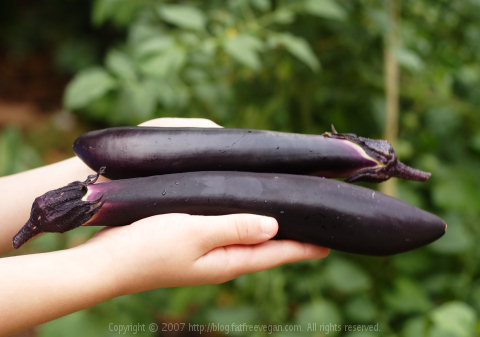I never buy cookbooks for the pictures, but I broke that rule a few months ago after previewing
Tropical Asian Cooking. It's nowhere near a vegan book, though there are several vegetarian or near-vegetarian recipes, but the photos were just so lovely that I had to have a copy. So I bought it and it sat for months by my reading chair with pieces of paper sticking out to mark potentially good recipes. But most of its dishes require more time and energy that I generally have, so none of them got made, until last night.
Spinach Kofta caught my eye because it was easily veganizable by replacing the cheese with tofu and some seasoning, and the fat could be reduced by baking instead of frying. Unfortunately, I wasn't sold on the eggplant sauce that accompanied the recipe, so after some thought, I decided to use a raita-style cucumber sauce instead.
I will not lie to you: It was a lot of work for a week night. The list of ingredients looks simple, until you realize that the potatoes and the spinach need to be cooked before the rest of the recipe is put together. But all in all, it was worth it. The kofta, crispy on the outside and tender on the inside, were mildly seasoned, and even E., who didn't want to try them at first, wound up cleaning her plate. And though they are seasoned with curry, I served them with pita bread and hummus, so consider them a cross-cultural kind of dish.
 Baked Spinach Kofta
Baked Spinach Kofta
(click for printer-friendly version)
2 medium red potatoes, about 12 ounces
6 ounces fresh spinach
2 ounces firm tofu
2 teaspoons nutritional yeast flakes
2 teaspoons lemon juice
1 teaspoon salt (reduce for low-sodium diets)
1 teaspoon cumin seeds
1/2 onion, minced
2 cloves garlic, minced
1 teaspoon minced fresh ginger
1/2 teaspoon garam masala
3 tablespoons chickpea flour (besan)
Peel the potatoes, dice them into 1/2-inch pieces, place them in a saucepan, and cover them with water. Boil until the potatoes are tender and then drain them well and mash. Set aside.
Bring a large pot of water to a boil. Add the spinach and blanch for one minute, or just until wilted. Drain well in a colander. Put the spinach along with the tofu, nutritional yeast, lemon juice and salt into a food processor and process until crumbly. Set aside.
Spray a large skillet with canola oil and bring it to medium-high heat. Add the cumin seeds and toast for one minute. Add the onions, garlic, and ginger and sauté until the onions are soft, about 3 minutes. Add the garam masala, stir, and immediately add the potatoes and the spinach mixture. Cook, stirring, for 3 more minutes. Remove from the heat and spoon into a large bowl.
Add the chickpea flour and stir well. Allow to cool until easy to handle. Shape into about 20 balls, approximately 1-inch in diameter. (Don't worry about getting them perfect; they will naturally flatten out some during baking.) Place on an oiled cookie sheet or a silicone baking mat:

Preheat oven to 450F. Bake for 10 minutes and then turn the kofta. Bake for 10 more minutes and turn again. Bake for 10 more minutes or until all sides are lightly browned.
Serve with Cucumber-Soy Yogurt sauce (below), garnished with tomatoes, red onion, and hot chile peppers. This makes a delicious stuffing for whole wheat pita bread or chapatis.
Makes 4 servings. Per serving: 116 Calories (kcal); 1g Total Fat; (9% calories from fat); 6g Protein; 22g Carbohydrate; 0mg Cholesterol; 568mg Sodium; 3g Fiber. Cucumber-Soy Yogurt Sauce
Cucumber-Soy Yogurt Sauce1 small or 1/2 large cucumber
1 cup plain soy yogurt
1/4 cup diced red onion
1-2 tablespoons minced mint leaves
1-3 tablespoons lime juice (use more if you are using store-bought soy yogurt because it tends to be sweetened)
1/4 teaspoon ground coriander
1/4 teaspoon ground cumin
salt and freshly ground pepper, to taste
Peel and finely dice the cucumber. Place the pieces in a colander and allow the liquid to drain while you mix the other ingredients in a bowl.
Before adding the cucumber, blot it lightly with a paper towel to remove excess moisture. Add it to the yogurt mixture and stir to combine. Refrigerate for at least 1/2 hour to allow the flavors to blend.

It's been a long time since I've participated in any food blog events, and I really regret that. The truth is, I just haven't made the time to keep up with what's going on in the blogging world, but recently I came across an event that I can really get behind:
The Heart of the Matter--Eating for Life, a monthly round-up of heart-friendly recipes from all over the world. Since this blog is all about eating the
healthiest diet possible (except for,
ahem, those
doughnut muffins), I thought it was time to join in, and these Baked Spinach Kofta are just perfect--very low in calories and fat and full of spinachy nutrition. This month's theme is vegetables, so be sure to check out all the fantastic and healthy recipes once the round-up is posted.
Tags: vegan recipes vegetarian cooking food fat-free
Labels: eat to live, gluten-free, soy, tbr

















 It's been a long time since I've participated in any food blog events, and I really regret that. The truth is, I just haven't made the time to keep up with what's going on in the blogging world, but recently I came across an event that I can really get behind:
It's been a long time since I've participated in any food blog events, and I really regret that. The truth is, I just haven't made the time to keep up with what's going on in the blogging world, but recently I came across an event that I can really get behind: 





















